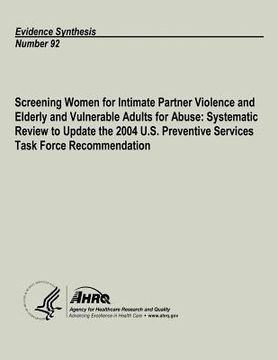Screening Women for Intimate Partner Violence and Elderly and Vulnerable Adults for Abuse: Systematic Review to Update the 2004 U.S. Preventive Servic (en Inglés)
Reseña del libro "Screening Women for Intimate Partner Violence and Elderly and Vulnerable Adults for Abuse: Systematic Review to Update the 2004 U.S. Preventive Servic (en Inglés)"
This review is an update for the U.S. Preventive Services Task Force (USPSTF) recommendation on screening women for intimate partner violence (IPV) and elderly and vulnerable adults for abuse and neglect. The USPSTF defines screening as obtaining information about abuse from individuals in health care settings who do not have complaints or obvious signs of abuse, such as physical injuries. In 2004, based on results of a previous review, the USPSTF found insufficient evidence to recommend for or against routine screening of women for IPV or of older adults or their caregivers for elder abuse. The USPSTF could not determine the balance between the benefits and harms of screening because of the lack of critical evidence, particularly the lack of trials of the effectiveness of screening in health care settings and the effectiveness of interventions to reduce harm from abuse. The USPSTF reviewed several existing screening instruments that demonstrated adequate internal consistency and were validated with longer instruments. However, none were evaluated against measurable violence or health outcomes. Also, despite reviewing an extensive literature on IPV, few studies provided data on screening and management to guide clinicians in practice, and there was little to no evidence from studies of elder abuse or neglect. The Centers for Disease Control and Prevention recognizes four categories of IPV, including physical violence, sexual violence, threat of physical or sexual violence, and psychological or emotional abuse. For this review, abuse and neglect of vulnerable adults is also considered with elder abuse. A vulnerable adult is a person age 18 years or older whose ability to perform the normal activities of daily living or to provide for his or her own care or protection is impaired due to a mental, emotional, long-term physical, or developmental disability or dysfunction, or brain damage. Definitions vary by State, and sometimes included in the definition is the receipt of personal care services from others. Types of elder abuse that also apply to vulnerable adults include physical abuse, sexual abuse, emotional or psychological abuse, neglect, abandonment, financial or material exploitation, and self neglect. Based on evidence gaps identified from the previous review and using the methods of the USPSTF, the USPSTF and Agency for Healthcare Research and Quality determined Key Questions for this review. Key Questions for IPV include: 1. Does screening asymptomatic women in health care settings for current, past, or increased risk for IPV reduce exposure to IPV, physical or mental harms, or mortality? 2. How effective are screening techniques in identifying asymptomatic women with current, past, or increased risk for IPV? 3. What are the adverse effects of screening for IPV? 4. For screen-detected women with current, past, or increased risk for IPV, how well do interventions reduce exposure to IPV, physical or mental harms, or mortality? 5. What are the adverse effects of interventions to reduce harm from IPV? Key Questions for elder and vulnerable adult abuse and neglect include: 1. Does screening asymptomatic elderly and vulnerable adults in health care settings for current, past, or increased risk for abuse and neglect reduce exposure to abuse and neglect, physical or mental harms, or mortality? 2. How effective are screening techniques in identifying asymptomatic elderly and vulnerable adults with current, past, or increased risk for abuse and neglect? 3. What are the adverse effects of screening for abuse and neglect of elderly and vulnerable adults? 4. For screen-detected elderly and vulnerable adults with current, past, or increased risk for abuse and neglect, how well do interventions reduce exposure to abuse and neglect, physical or mental harms, or mortality? 5. What are the adverse effects of interventions to reduce harm from abuse and neglect?

